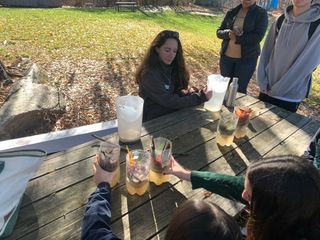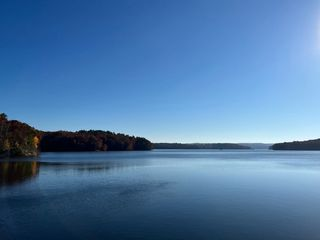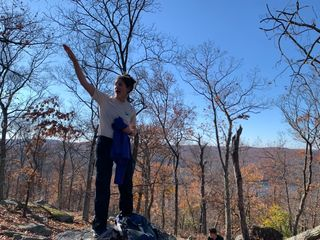A Day Spent Upstate Learning About New York City’s Water Supply: The Benefits of Field Trips
I went on the first field trip of my Bronx Science career in November and I learned more than I had that entire week. We need more field trips in school to get students out and learning in the real world.

Students compare their water filters in an activity led by Cross River Reservoir educator Jessica Alba modeling the natural water filtration trees perform.
“I’ve learned more today than I have in the past two months of school,” Regan Toriello ’23 said to me as we boarded a coach bus with the rest of our Green Design and Clean Technology class. We were heading back to Bronx Science after a day spent upstate learning about New York City’s water supply.
“The motivation for this field trip was that I wanted students to have a positive experience in nature, and that’s not something you can do in the span of 40 minutes,” said Mr. Sarker of the Physical Science department and the leader of the Green Design class. “That led to broader questions like ‘what are students’ relationship with nature? How do they engage with nature?’ and that’s what led to the field trip.”
We began our day at the Cross River Reservoir in Katonah, New York, where our instructors for the day, Tyler van Fleet and Jessica Alba, introduced us to the basics of New York City’s water system. Walking across the dam and looking around at the calm body of water with gentle foliage-lined slopes ringing the edges and a crisp fall breeze blowing around us, I felt energized to be learning in a new environment.
“The environment boosted my ability to learn along with my emotional health. Normally early in the morning I have to fight the urge to sleep, but on the field trip I was energized by the beautiful view from the dam at the Cross River Reservoir,” said Stefan Inderbitzin ’23, another student in the Green Design class.

There are nineteen reservoirs divided between two watersheds that supply New York City’s water. During the field trip, we learned that a watershed is an area of land where all flowing surface water converges to one point or flows into another body of water. The first of the watersheds is more well-known, the Catskill-Delaware watershed. The second, the Croton watershed, is much smaller. The Cross River Reservoir, where we visited, is part of the Croton watershed and it holds 10 billion gallons of water, only a 10-day supply for New York City which uses 1 billion gallons of water every day. Taken at face value, these facts would appear to me as arbitrary numbers that don’t mean anything. But in that moment, staring at the water that I knew would soon reach the tap in my kitchen, I was fascinated. After our visit to the Cross River Reservoir, my classmates and I got back on the bus and drove to Hamlet, New York to the Green Chimneys Clearpool Campus. Here, we split into groups to explore the nature around us and learn about the roles of trees in a watershed.
In one group, we went down to a serene pond, whose water ends up as our drinking water, to examine how trees naturally filter our water. Around 90% of NYC’s drinking water is filtered by trees alone, and occasionally, 100% of our water can be filtered by trees. In our activity, we had ten minutes to build water filters using the natural materials around us – sticks, leaves, rocks, moss, or anything else we could find. We then tested our filters by pouring dirty water through them and measuring the turbidity of the filtered water using a turbidity tube.

“This hands-on experience was so much more engaging and memorable than a class lesson and left me feeling more passionate about preserving our water system,” said Camila Kulahlioglu ’23.
In the other group, we took a short walk through a model forest, an area of forest that the New York Department of Environmental Protection uses to demonstrate Best Management Practices, or BPMs. Our instructor, Tyler, showed us how they have built runoff diversions and stream buffers to protect the ground and the water sources from any waste or erosion. We observed how many different types of leaves there were in the forest and discussed why having biodiverse forests is advantageous for a healthy watershed.
“Being surrounded by the systems we were learning about allowed me to better understand how each part fits into the whole,” said Interbitzin.
Our day upstate concluded with a short hike through the forest which revealed a stunning view of many of the lakes and ponds that supply our drinking water.

A study done by Education Next found that enriching field trips contribute to the development of stronger critical thinking skills. The impact is even greater for students who come from less privileged backgrounds, who are less likely to experience cultural institutions like museums, monuments, or natural sites unless schools facilitate field trips.
I urge the implementation of more field trips such as this one, both at Bronx Science and throughout the NYC DOE public school system. Field trips allow you to discover new passions, find ways to engage with the topics you’re learning about, and make connections across subjects that would only be possible by stepping just a foot outside of the box.
“This hands-on experience was so much more engaging and memorable than a class lesson and left me feeling more passionate about preserving our water system,” said Camila Kulahlioglu ’23.
Helen Stone is the Editor in Chief and Facebook Editor for 'The Science Survey.' She is interested in journalistic writing because she believes that a...
Camila Kulahlioglu is an Editor-in-Chief for ‘The Science Survey.’ She hopes that her writing will inspire her peers to find new literary passions...










